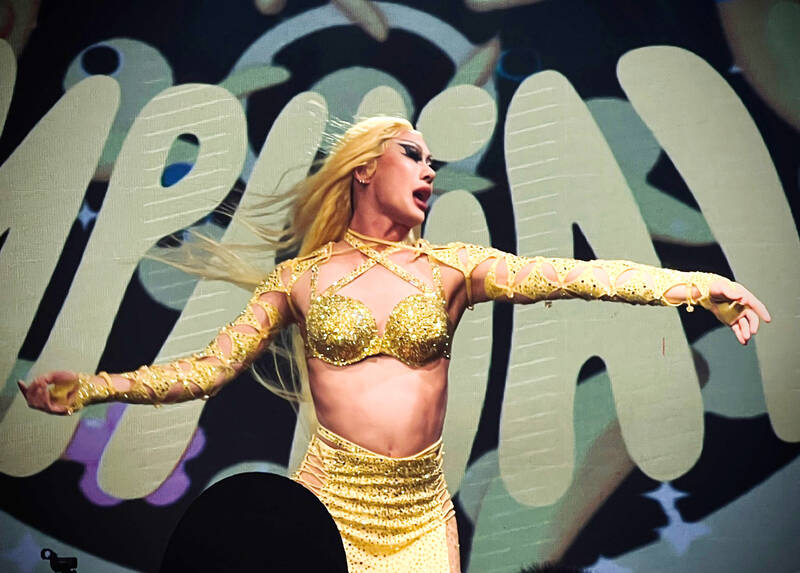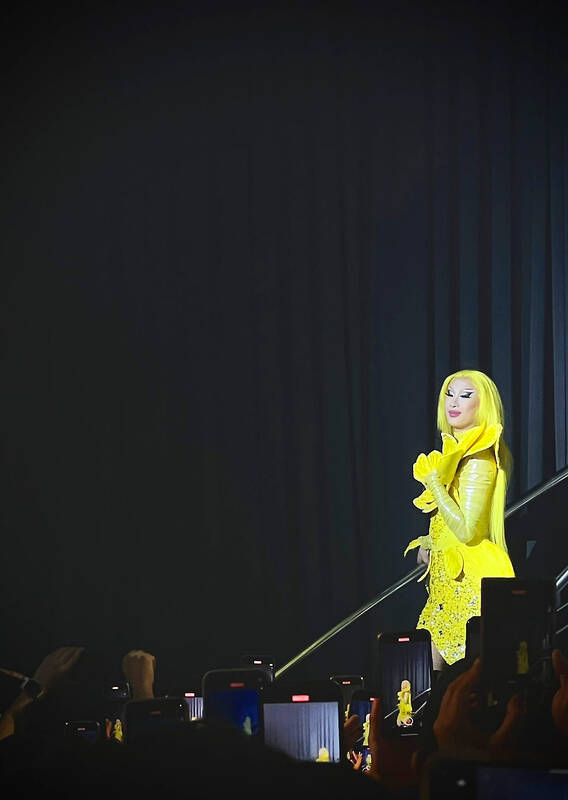The next act needs no introduction: an endless sea of anticipating drag fanatics dressed in yellow banana motifs have waited months for this moment. Crowded shoulder to shoulder, clacking our neon yellow fans emblazoned U Better Werq, cheering our voices hoarse, collectively we scream: Nymphia! Wind!
The spotlight pans to the spiral staircase left of stage, and atop stands Nymphia — the drag persona of Leo Tsao (曹米駬), who goes by he/him in everyday life, but she/her when in drag — in all her yellow glory: sparkling banana-yellow dress, trademark pin-straight canary wig and exaggerated winged-out eyeliner.
The electric guitar shrieks the intro to You and I by Lady Gaga, and she descends to her adoring audience, throwing her arms wide and lip-syncing the opening lyrics: “It’s been a long time since I came around, been a long time but I’m back in town.”

Photo: Hollie Younger
NYMPHIA NAILS IT
And back she is. Since taking the crown as America’s Next Drag Superstar on season 16 of US smash-hit reality-TV competition Ru Paul’s Drag Race back in April, tonight is Nymphia’s first public performance in Taiwan.
Tonight’s dress code: yellow. Her signature color serves as a celebration of Asian identity, and a symbol of joy, with her trademark Taiwanese yellow water lily a powerful metaphor for rising to greatness despite humble beginnings, and her beloved banana motif a metaphor requiring less explanation.

Photo: Hollie Younger
Taipei International Drag Fest Vol.2 is Taiwan’s biggest drag event of the year — over 1,500 tickets sold out within minutes. With both a matinee and evening show at venue Hanaspace (花漾展演空間), this is Nymphia’s heartfelt homage to her supporters, the “Banana Believers.”
Tonight, everyone around the venue it seems is wearing yellow. Drag queens clomp around 7-11 in lace-up stilettos. Queer kids in stage makeup queue for cans of Taiwan Beer. All a far cry from Nymphia’s new home stateside, where drag performers are still fighting for acceptance.
With more than 50 drag performers, this showcase of international drag excellence is a gathering of Nymphia’s friends old and new, from home and away.

Photo: Hollie Younger
Nymphia’s season 16 co-stars Plane Jane and Mirage also joined the lineup. Performing her iconically camp hit from the TV show, Burger Finger, Boston’s Plane Jane licks her finger seductively, whipping her platinum blonde wig, then eats a burger on stage and invites us to smell her burger finger.
Familiar faces from Taiwan’s drag scene also grace the stage. Standout troupe Haus of Dimensions’ Taipei Popcorn gives us an enrapturing performance as an enchanting and confusingly sexy seven-foot-tall Voldemort in ghoulish black lace.
Between acts, the crowd drools over Magic Mike-style male stripper troupe Haus of Booty Call, grinding provocatively and stuffing NT$1,000 bills into hot pink speedos.

Photo: Hollie Younger
Nymphia’s next number, I’m Alive by Sia, sees her screeching the powerhouse hit, before running and jumping to hang monkey-bars style from the staircase, swinging like a chandelier and pulling comically contorted facial expressions.
Mid-performance, she freefalls backwards into the awaiting arms of fans, surging to carry her overhead. Her star power is undeniable. In the words of Ru Paul, the audience is “gooped and gagged” (translation: stunned).
Nymphia’s often garners inspiration from East Asian culture, Taiwan’s temples and, of course, bubble tea.
For the fierce finale, she brings the house down as hundreds of black balloons descend on the arena — a callback to her final lip-sync on Ru Paul’s Drag Race, when she stunned the judges with black boba balloons bursting from a bubble-tea-decorated cloak.
When the three-hour extravaganza comes to a close, I am left voice cracked and legs shaking violently from straining on tiptoes — anyone would think I had been the one in 6-inch stiletto boots backflipping down the stage.
REPRESENTATION
As the first Taiwanese contestant on Ru Paul’s Drag Race and the first East Asian winner, Nymphia is not just using her platform, she’s building a stage to showcase Taiwan, celebrate her roots and bring with her the queens that raised her.
Nymphia has been busy since her return. From promoting the Taipei drag scene she called home for five years, to addressing protestors outside the legislative Yuan, to dazzling former president Tsai Ing-wen (蔡英文) with the world’s first drag performance in a Presidential Office — picture a bedazzled drag queen in a unitard cartwheeling into the splits, stilettoed legs spread wide before the bust of Republic of China (ROC) founding father Sun Yat Sen (孫逸仙) and a confused yet delighted Tsai.
Nymphia went on to personally thank the president for opportunities her administration had afforded to LGBTQ+ performers in Taiwan.
Tonight feels like just the beginning and there seems to be no stopping Nymphia on her conquest put Taiwan and Taiwanese drag on the map, showing the world our beautiful island’s boundless charisma, uniqueness, nerve and talent.

April 14 to April 20 In March 1947, Sising Katadrepan urged the government to drop the “high mountain people” (高山族) designation for Indigenous Taiwanese and refer to them as “Taiwan people” (台灣族). He considered the term derogatory, arguing that it made them sound like animals. The Taiwan Provincial Government agreed to stop using the term, stating that Indigenous Taiwanese suffered all sorts of discrimination and oppression under the Japanese and were forced to live in the mountains as outsiders to society. Now, under the new regime, they would be seen as equals, thus they should be henceforth

Last week, the the National Immigration Agency (NIA) told the legislature that more than 10,000 naturalized Taiwanese citizens from the People’s Republic of China (PRC) risked having their citizenship revoked if they failed to provide proof that they had renounced their Chinese household registration within the next three months. Renunciation is required under the Act Governing Relations Between the People of the Taiwan Area and the Mainland Area (臺灣地區與大陸地區人民關係條例), as amended in 2004, though it was only a legal requirement after 2000. Prior to that, it had been only an administrative requirement since the Nationality Act (國籍法) was established in

With over 80 works on display, this is Louise Bourgeois’ first solo show in Taiwan. Visitors are invited to traverse her world of love and hate, vengeance and acceptance, trauma and reconciliation. Dominating the entrance, the nine-foot-tall Crouching Spider (2003) greets visitors. The creature looms behind the glass facade, symbolic protector and gatekeeper to the intimate journey ahead. Bourgeois, best known for her giant spider sculptures, is one of the most influential artist of the twentieth century. Blending vulnerability and defiance through themes of sexuality, trauma and identity, her work reshaped the landscape of contemporary art with fearless honesty. “People are influenced by

The remains of this Japanese-era trail designed to protect the camphor industry make for a scenic day-hike, a fascinating overnight hike or a challenging multi-day adventure Maolin District (茂林) in Kaohsiung is well known for beautiful roadside scenery, waterfalls, the annual butterfly migration and indigenous culture. A lesser known but worthwhile destination here lies along the very top of the valley: the Liugui Security Path (六龜警備道). This relic of the Japanese era once isolated the Maolin valley from the outside world but now serves to draw tourists in. The path originally ran for about 50km, but not all of this trail is still easily walkable. The nicest section for a simple day hike is the heavily trafficked southern section above Maolin and Wanshan (萬山) villages. Remains of